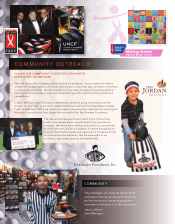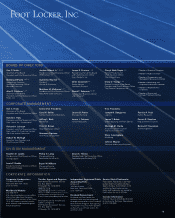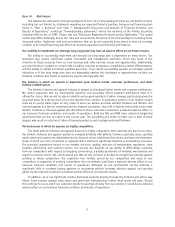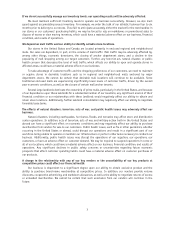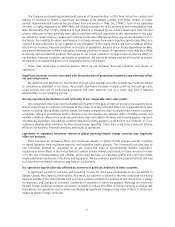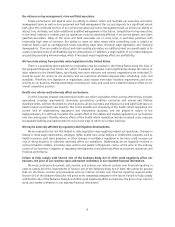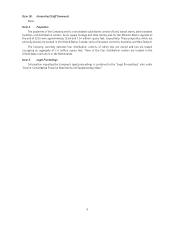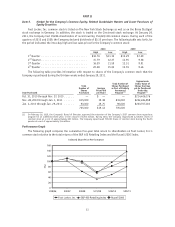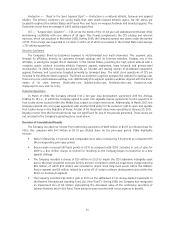Foot Locker 2010 Annual Report Download - page 23
Download and view the complete annual report
Please find page 23 of the 2010 Foot Locker annual report below. You can navigate through the pages in the report by either clicking on the pages listed below, or by using the keyword search tool below to find specific information within the annual report.The Company purchased approximately 82 percent of its merchandise in 2010 from its top five vendors and
expects to continue to obtain a significant percentage of its athletic product from these vendors in future
periods. Approximately 63 percent was purchased from one vendor — Nike, Inc. (‘‘Nike’’). Each of our operating
divisions is highly dependent on Nike; they individually purchase 46 to 81 percent of their merchandise from
Nike. Merchandise that is high profile and in high demand is allocated by our vendors based upon their internal
criteria. Although we have generally been able to purchase sufficient quantities of this merchandise in the past,
we cannot be certain that our vendors will continue to allocate sufficient amounts of such merchandise to us in
the future. Our inability to obtain merchandise in a timely manner from major suppliers (particularly Nike) as a
result of business decisions by our suppliers or any disruption in the supply chain could have a material adverse
effect on our business, financial condition, and results of operations. Because of our strong dependence on Nike,
any adverse development in Nike’s reputation, financial condition or results of operations or the inability of Nike
to develop and manufacture products that appeal to our target customers could also have an adverse effect on
our business, financial condition, and results of operations. We cannot be certain that we will be able to acquire
merchandise at competitive prices or on competitive terms in the future.
These risks could have a material adverse effect on our business, financial condition, and results of
operations.
Significant increases in costs associated with the production of promotional materials may adversely affect
our operating income.
We advertise and promote our merchandise through print catalogs and other promotional materials mailed
to consumers or displayed in our stores. As a result, significant increases in paper, printing, and postage costs
could increase the cost of producing promotional and other materials and, as a result, may have a material
adverse effect on our operating income.
We may experience fluctuations in and cyclicality of our comparable-store sales results.
Our comparable-store sales have fluctuated significantly in the past, on both an annual and a quarterly basis,
and we expect them to continue to fluctuate in the future. A variety of factors affect our comparable-store sales
results, including, among others, fashion trends, the highly competitive retail store sales environment, economic
conditions, timing of promotional events, changes in our merchandise mix, calendar shifts of holiday periods, and
weather conditions. Many of our products, particularly high-end athletic footwear and licensed apparel, represent
discretionary purchases. Accordingly, customer demand for these products could decline in a recession or if our
customers develop other priorities for their discretionary spending. These risks could have a material adverse
effect on our business, financial condition, and results of operations.
Legislative or regulatory initiatives related to global warming/climate change concerns may negatively
affect our business.
There has been an increasing focus and continuous debate on global climate change recently, including
increased attention from regulatory agencies and legislative bodies globally. This increased focus may lead to
new initiatives directed at regulating an as yet unspecified array of environmental matters. Legislative,
regulatory or other efforts in the United States to combat climate change could result in future increases in taxes
or in the cost of transportation and utilities, which could decrease our operating profits and could necessitate
future additional investments in facilities and equipment. We are unable to predict the potential effects that any
such future environmental initiatives may have on our business.
Our operations may be adversely affected by economic or political conditions in other countries.
A significant portion of our sales and operating income for 2010 were attributable to our operations in
Europe, Canada, New Zealand, and Australia. As a result, our business is subject to the risks associated with doing
business outside of the United States such as foreign customer preferences, political unrest, disruptions or delays
in shipments, and changes in economic conditions in countries in which we operate. Although we enter into
forward foreign exchange contracts and option contracts to reduce the effect of foreign currency exchange rate
fluctuations, our operations may be adversely affected by significant changes in the value of the U.S. dollar as it
relates to certain foreign currencies.
4



